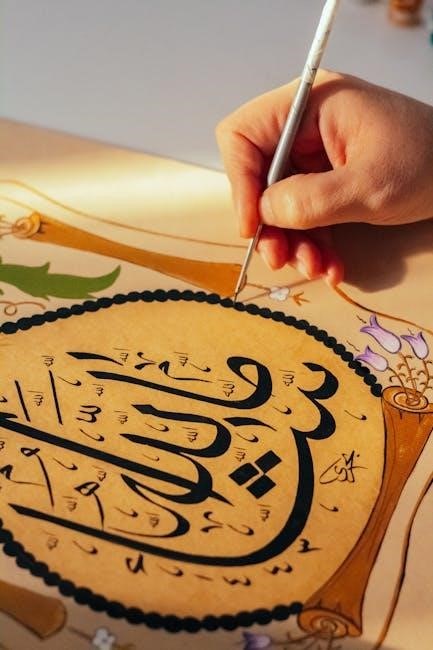The Arabic alphabet is a foundational element of the Arabic language, consisting of 28 letters. It is written from right to left and is cursive in nature.
Overview of the Arabic Alphabet

The Arabic alphabet is a script consisting of 28 letters, written from right to left. It is a cursive script, meaning letters are connected in a flowing manner. Each letter has up to four distinct forms: isolated, initial, medial, and final, depending on its position in a word. This unique feature makes the Arabic alphabet both beautiful and complex. The script is not only used for the Arabic language but also for other languages like Persian and Urdu. PDF resources, such as workbooks and tracing guides, are widely available to help learners master the alphabet. These resources often include interactive worksheets and pronunciation guides, making learning accessible and engaging. Understanding the Arabic alphabet is essential for grasping the language and its cultural significance.
Importance of Learning Arabic Letters
Learning Arabic letters is crucial for understanding the Arabic language and its cultural heritage. The alphabet forms the basis of reading, writing, and communication in Arabic. Each letter carries unique sounds and shapes, essential for pronunciation and comprehension. PDF resources, such as workbooks and guides, provide structured methods for mastering these letters. They often include tracing exercises, pronunciation tips, and interactive activities, making learning engaging and effective. Acquiring this skill opens doors to exploring Arabic literature, religious texts, and daily communication. Additionally, it enhances cognitive abilities and cultural appreciation. For beginners, especially children, these PDF tools offer a comprehensive and accessible way to start their learning journey. Thus, learning Arabic letters is not just about acquiring a skill but also about connecting with a rich linguistic tradition.

Structure of the Arabic Alphabet
The Arabic alphabet consists of 28 letters, written right-to-left in a cursive script. Each letter has distinct forms: isolated, initial, medial, and final, depending on its position in a word. The script evolved from earlier alphabets like Aramaic, with unique connections between letters, creating a flowing aesthetic in written text.
Total Number of Letters
The Arabic alphabet consists of 28 letters, each with distinct shapes and sounds. These letters are foundational for reading and writing in Arabic, forming the basis of the language. Unlike the Latin alphabet, Arabic letters are cursive, meaning they connect to each other in a flowing manner. The 28-letter structure includes consonants and vowels, with additional markings to denote short vowels. This system allows for precise pronunciation and meaning in written texts. Resources like PDF guides provide detailed visuals, making it easier to learn and practice each letter’s form. Understanding the total number of letters is crucial for mastering the Arabic script, as each letter’s unique shape and position affects pronunciation and word formation. These resources often include tracing exercises to help learners familiarize themselves with the correct strokes and connections required for each letter.
Forms of Arabic Letters (Isolated, Initial, Medial, Final)
Arabic letters have four distinct forms: isolated, initial, medial, and final. These forms dictate how letters connect to each other in a word. In their isolated form, letters stand alone and are not connected to any other letters. In their initial form, they appear at the beginning of a word and are connected to the following letter. The medial form is used when a letter is in the middle of a word, connecting to both the preceding and following letters. Finally, the final form appears at the end of a word, connecting only to the previous letter. These forms are crucial for proper handwriting and readability. PDF guides often include charts and exercises to practice these forms, helping learners master the cursive nature of Arabic script. Tracing worksheets in PDF format are particularly useful for memorizing the correct strokes and connections required for each form.
Similarities and Differences with Other Alphabets
The Arabic alphabet shares some similarities with other alphabets, such as its cursive nature and the representation of distinct sounds. However, it differs significantly in direction, as it is written from right to left. Unlike the Latin alphabet, Arabic letters have no uppercase or lowercase forms and are inherently cursive. The Arabic script also lacks vowels in its basic form, relying instead on diacritical marks to indicate vowel sounds. PDF guides often highlight these differences, providing comparative charts between Arabic and other scripts. For example, the absence of letters like “C” or “V” in Arabic is offset by unique sounds represented by letters like “ض” and “ظ.” These distinctions make the Arabic alphabet both unique and fascinating, with PDF resources offering detailed comparisons to aid learners in understanding its structure and pronunciation. Such resources are invaluable for those exploring the Arabic script for the first time.

Historical Background
The Arabic alphabet originated from the Aramaic script, evolving in the 5th century. Early development was influenced by regional dialects and religious needs. PDF guides provide detailed historical context.
Origin and Evolution of the Arabic Alphabet
The Arabic alphabet traces its roots to the Aramaic script, which was widely used in the Middle East during the 5th century CE. Over time, it evolved through interactions with various cultures and languages, adapting to the unique needs of Arabic. The script became more cursive and distinct, with the addition of diacritical marks to clarify pronunciation. Historical records indicate that the Arabic alphabet fully took shape around the 5th century, influenced by regional dialects and the necessity for a standardized system to record the Quran. PDF resources provide detailed timelines and examples of its progression, making it easier to understand its transformation into the modern script used today.
Development of the Arabic Script
The Arabic script underwent significant development over centuries, emerging as a refined and expressive writing system. Early iterations were influenced by the Aramaic script, which served as its foundation. By the 5th century CE, the Arabic script began to take its distinct form, incorporating unique letter shapes and cursive connections. The addition of diacritical marks in the 8th century CE enhanced clarity, distinguishing similar letters and aiding in pronunciation. Islamic expansion further spread the script, adapting it to various languages like Persian and Turkish. The script’s evolution included artistic advancements, such as calligraphy, which became a cornerstone of Islamic art. Today, the Arabic script is standardized into 28 letters, with vowel markings and contextual forms. PDF guides and historical documents detail this journey, offering insights into its transformation and enduring relevance in modern times.

Learning Resources
Various PDF guides, workbooks, and interactive worksheets are available for mastering Arabic letters. These resources offer tracing exercises, pronunciation tips, and practice pages for learners of all levels.
Popular PDF Guides for Arabic Letters

A 30-page guide to the Arabic alphabet by Mohamed AL-Yamani is widely regarded for its clarity. It includes detailed stroke directions and pronunciation tips. Another popular resource is the My Arabic Alphabet Workbook, featuring tracing exercises and quizzes. This workbook is designed for children and beginners, offering a fun, interactive approach to learning. Additionally, the Arabic Alphabet Tracing Workbook provides large, clear letter forms for practice. These PDFs often include colorable letters and words, making learning engaging. Many guides are available for free download, offering comprehensive lessons on letterforms, pronunciation, and combinations. They serve as invaluable tools for both self-study and classroom use, catering to learners of all ages and proficiency levels.
Interactive Worksheets for Practicing Arabic Letters
Interactive PDF worksheets are an excellent way to practice Arabic letters, offering engaging activities for learners. These worksheets often include tracing exercises, letter matching games, and coloring pages. They are designed to help learners master the correct stroke order and recognize letterforms. Many PDFs feature large, clear fonts, making them ideal for children and beginners. Some worksheets also include bilingual Arabic-English content, aiding language learners in associating sounds and meanings. Interactive elements, such as fill-in-the-blank exercises and letter puzzles, enhance retention and make learning fun. Additionally, these PDFs often allow users to write directly on the document, providing a digital space for practice. Overall, interactive worksheets are a valuable resource for anyone looking to improve their Arabic letter recognition and writing skills in an enjoyable and effective manner.
Recommended Workbooks for Beginners
For those starting their journey with Arabic letters, recommended workbooks provide a structured and comprehensive approach. These workbooks are designed to introduce learners to the fundamentals of the Arabic alphabet, focusing on letter recognition, pronunciation, and basic writing skills. Many popular workbooks, such as “My Arabic Alphabet Workbook,” offer step-by-step tracing exercises to help master the correct stroke order of each letter. They often include bilingual content, featuring Arabic letters alongside their English translations, making them ideal for language learners. Some workbooks also incorporate interactive elements, such as fill-in-the-blank exercises and matching games, to engage learners and reinforce retention. Additionally, these resources frequently include tips on pronunciation and vowel placement, ensuring a solid foundation for further study. Overall, these workbooks are essential tools for beginners seeking to build confidence in reading and writing Arabic.

Arabic Letters in PDF Format
Arabic letters in PDF format provide a convenient way to learn and practice the alphabet. These resources often include tracing exercises, pronunciation guides, and interactive elements for effective learning.
Features of Arabic Letters PDFs
Arabic letters PDFs are designed to facilitate learning through interactive and visual elements. They often include tracing exercises, pronunciation guides, and colorful illustrations to engage learners. Many PDFs feature isolated, initial, medial, and final letter forms, helping users understand how letters change in different positions. Some resources incorporate audio clips for accurate pronunciation practice. These PDFs are organized into sections, covering the alphabet systematically. They also offer worksheets for daily practice, allowing learners to reinforce their skills. Additionally, bilingual Arabic-English PDFs cater to non-native speakers, making learning more accessible. These resources are compatible with various devices, ensuring flexibility for learners on the go. Overall, Arabic letters PDFs combine comprehensive content with user-friendly designs to enhance the learning experience.
Downloading and Using Arabic Alphabet PDFs
Downloading Arabic alphabet PDFs is a convenient way to access learning materials. Many websites offer direct download options, ensuring quick and easy access to resources. These PDFs are often free or low-cost, making them accessible to a wide audience. Once downloaded, learners can use the PDFs offline, practicing anytime and anywhere. The files typically include tracing exercises, letter forms, and pronunciation guides, providing a comprehensive learning experience. Some PDFs are designed for specific needs, such as workbooks for children or advanced learners. They are compatible with various devices, including smartphones, tablets, and computers. Users can print the worksheets for hands-on practice or use digital tools to interact with the content. Overall, Arabic alphabet PDFs are versatile resources that cater to different learning styles and preferences, making them an essential tool for mastering the Arabic script.
Benefits of Learning from PDF Resources

Learning from PDF resources offers numerous advantages for mastering Arabic letters. These files are highly accessible and can be downloaded from various websites, providing learners with instant access to study materials. PDFs are often structured to include visual aids like charts, tracing exercises, and letter forms, which enhance understanding. They cater to different learning styles, allowing users to study at their own pace. Many PDFs are designed for specific needs, such as workbooks for children or advanced learners, ensuring targeted practice; Additionally, PDFs can be easily shared and printed, making them a convenient option for group or individual study. The ability to use them offline also makes them ideal for learners with limited internet access. Overall, PDF resources provide a flexible, comprehensive, and user-friendly approach to learning Arabic letters, making them an invaluable tool for language acquisition.

Transliteration and Pronunciation
Transliteration systems convert Arabic letters into Latin script, aiding pronunciation. PDF guides provide detailed visual aids and practice exercises to master these sounds effectively for learners.
Guide to Transliterating Arabic Letters
Transliterating Arabic letters into Latin script is a common practice for learners. PDF guides often include detailed charts mapping each Arabic letter to its Latin equivalent, ensuring accuracy. These resources typically follow standardized systems, such as the IAST or ISO standards, to maintain consistency. For example, the letter “ت” is transliterated as “t,” while “ث” becomes “th.” Vowels like “ا” (alif) are represented as “ā” or “a,” depending on their length. Many PDF workbooks include exercises where learners can practice transliterating words and phrases, reinforcing their understanding of both the Arabic script and its Latin equivalents. This method is particularly useful for beginners who are still mastering the Arabic alphabet’s unique shapes and sounds.
Understanding the Sounds of Arabic Letters
Mastering the sounds of Arabic letters is crucial for proper pronunciation. Each letter has a distinct sound, and some, like “ق” (qāf) and “خ” (khā’), have no direct English equivalents. PDF guides often include charts that link letters to their phonetic representations, aiding learners in reproducing sounds accurately. Audio resources within these PDFs allow learners to hear native speakers, enhancing their ability to mimic intonations and accents. Regular practice with these tools helps learners differentiate between similar sounds, such as “ซ” (sād) and “ص” (ṣād), which are easily confused. Consistent exposure to these sounds through PDF-based exercises ensures learners develop an ear for the language, making speech and comprehension more natural over time.

Practice and Application
Practice is essential for mastering Arabic letters. Use PDF workbooks to trace and write letters, then combine them into words for practical application.
Tracing and Writing Arabic Letters
Mastery of Arabic letters begins with tracing and writing. PDF guides provide clear templates for each letter in its isolated form, helping learners develop proper strokes and connections. These resources often include large, traceable fonts, making it easier for beginners to practice accurately. By consistently tracing and writing each letter, learners build muscle memory and improve their handwriting skills. Many PDFs also offer space for repeated practice, ensuring familiarity with each letter’s shape and form. Tracing is particularly beneficial for children, as it introduces them to the cursive nature of Arabic script. Regular practice with these tools enhances both accuracy and fluency in writing Arabic letters effectively.
Combining Letters to Form Words
Once learners are comfortable writing individual Arabic letters, the next step is combining them to form words. This process requires understanding how letters connect in their initial, medial, and final forms. PDF resources often include exercises that guide learners through this transition, offering step-by-step examples of letter combinations. Many workbooks and guides provide practice pages where users can trace and write common Arabic words, helping them grasp the flow of the script. These materials also highlight how vowel markings influence word formation and pronunciation. By practicing letter combinations, learners develop the ability to recognize and write basic Arabic words, which is essential for progressing in reading and writing. Regular practice with PDF-based exercises ensures a smooth transition from individual letters to meaningful words, building foundational skills in Arabic literacy.
Using PDF Worksheets for Daily Practice
PDF worksheets are an excellent tool for daily practice when learning Arabic letters. They provide structured exercises, such as tracing letters, writing words, and identifying shapes, which help reinforce muscle memory and improve handwriting skills. Many worksheets include vowel markings, allowing learners to practice pronunciation alongside writing. These resources often feature progress trackers, enabling users to monitor their improvement over time. Additionally, PDFs are easily accessible and can be downloaded for offline use, making them a convenient option for consistent practice. Worksheets are designed for all skill levels, from beginners tracing isolated letters to advanced learners forming complex words. Regular use of these materials helps build confidence and fluency in reading and writing Arabic. They are also customizable, allowing learners to focus on specific letters or sounds that challenge them. Overall, PDF worksheets are a valuable companion for anyone mastering the Arabic alphabet.
